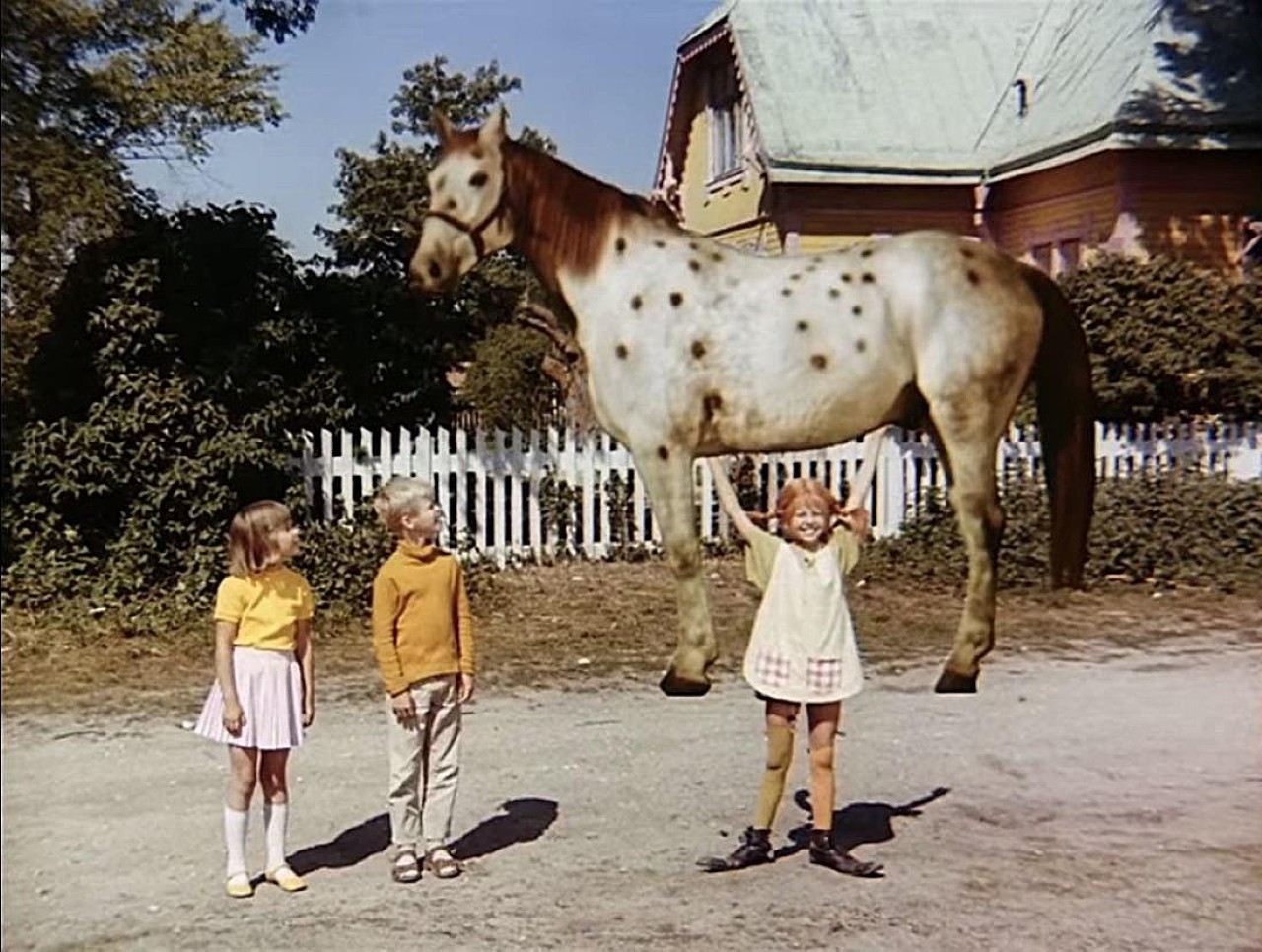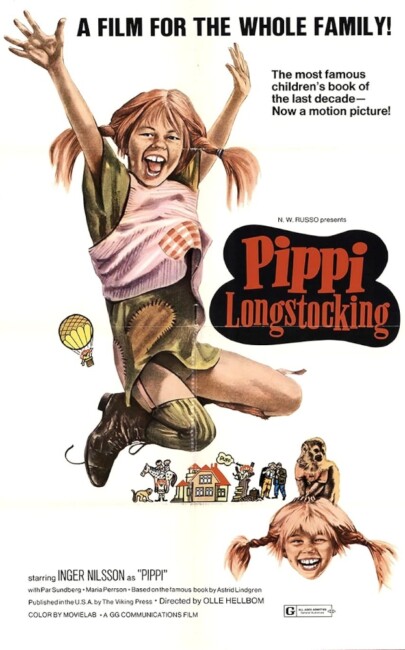(Pippi Långstrump)
Sweden/West Germany. 1969.
Crew
Director – Olle Helbom, Based on Characters Created by Astrid Lindgren, Producer – Olle Nordeman, Photography – Kalle Berholm, Music – Konrad Elfers. Production Company – Beta Films/KB Nord Art AB.
Cast
Inger Nilsson (Pippi Longstocking), Par Sundberg (Tommy Settigren), Maria Persson (Anneka Settigren), Margot Trooger (Miss Prossel), Beppe Wolgren (Captain Ephriam Longstocking), Hans Clarin, Paul Esser, Ulf G. Johnson, Gothe Grefbo
Plot
Tommy and Anna Settigren discover that a new girl has moved in next door to them at the Villa Villekula. This turns out to be the fun-loving and unconventional Pippi Longstocking. Pippi lives on her own with only her monkey Mr Nielson as companion after her father, a sea captain, was blown overboard in a storm. Tommy and Anna join in the wild and crazy fun that Pippi manages to create wherever she goes. During these exploits, they come up against two escaped crooks who are trying to steal Pippi’s supply of gold coins. They must also deal with the uptight social worker Miss Prossel who tries to have Pippi placed into a children’s home.
Pippi Longstocking was the creation of Swedish author Astrid Lindgren (1907-2002) and has become a much-loved children’s character the world over. Pippi Longstocking, or Pippi Långstrump to give her her original Swedish name, first appeared in Lindgren’s second published book Pippi Longstocking/Pippi Långstrump (1945). Pippi was dreamt up by Lindgren’s daughter Karin while she was sick and Lindgren published the book for Karin’s tenth birthday. The character of Pippi Longstocking caused some controversy in Sweden when the books came out. Pippi was often wilfully disrespectful of adults and disregarding of authority and it was argued that children’s literature should be setting a morally edifying example. Despite various calls for the Pippi stories to be banned in some countries, Pippi became Astrid Lindgren’s most well known creation.
Lindgren published four other Pippi Longstocking books – Pippi Goes on Board (1946), Pippi in the South Seas (1948), Pippi Goes on Holiday (1974) and Pippi’s After Christmas Party (1979). Lindgren wrote numerous other children’s books during her lifetime, most notably creating the characters of Ronia the Robber’s Daughter and the bizarre character of Karlsson-on-the-Roof, a fat man who lives on the roof of his house and has a built-in helicopter on his back that is activated through a button in his stomach. Astrid Lindgren became regarded as a Swedish cultural landmark – there have been awards named in her honour, her home is an historic attraction, she appears on a stamp and there was even a satellite named after her.
The character of Pippi Longstocking has been adapted to the screen a number of times. There was a Swedish-made film version Pippi Långstrump (1949) but this was disliked by Astrid Lindgren for its derivation from her creation. This Swedish/West German co-production was the second screen adaptation of the books (others are listed at the bottom of the page). This film version actually emerged out of a tv series Pippi Longstocking (1969), which ran for thirteen thirty-minute episodes. A handful of the first few episodes of the tv series were edited together to make this film. The tv series and film version proved popular in dubbed international release and three further film versions were released (see below). Astrid Lindgren was involved in the production and retained creative control over the way that her character was translated to the screen.

This version of Pippi Longstocking may have been popular in its day but today the film is hard going. The books are nonsensical delights where you cannot help but get caught up in Pippi’s absurdist exploits and tall tales. However, on screen here, the books’ fantasy elements have been drastically throttled, indeed bled out almost to the point of non-existence. The most we get is Pippi being able to wield her super-strength to throw the two crooks atop a cupboard. Moreover, the film is almost entirely plotless, consisting of various runnings around the backyard of a rather mundane Villa Villekula, the town and Mrs Settigren’s coffee party. The most exciting things get is when the kids take off in a hot-air balloon at the end. The film is dreary on almost counts – the photography is lifeless and the direction near soporific.
On the plus side, the film has an occasional light amusement in some of its bubbly, insubstantial non-sequitirs. Inger Nilsson, with her red hair wound into plaits that stick out horizontally, plays well as Pippi – although the two supporting children are colourless. (This is a film where the English dubbing for once works surprisingly in favour of the characterisations). Eventually the proceedings ramble on far too long – a custom criminal to the sequels – and at the end of the day one wishes there had been more money to give Astrid Lindgren’s stories their true worth.
The sequels were:– Pippi Goes on Board (1970), Pippi in the South Seas (1970) and Pippi on the Run (1973). Pippi Longstocking (1985) was a further American tv movie adaptation starring Carrie Kei Heim. The most well-known remake was The New Adventures of Pippi Longstocking (1988), a Hollywood version starring Tami Erin as Pippi, which virtually remakes this film. There was also the Canadian co-produced Pippi Longstocking (1997), a further animated version of the tales, which is probably the best translation of Pippi to the screen to date. This spawned a sequel Pippi’s Adventures in the South Seas (1999). There was also a 1982 Russian musical adaptation about which little is known.
Trailer here


